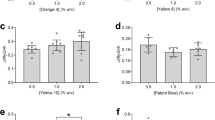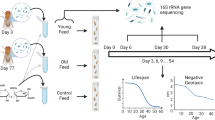Abstract
A critical requirement for research using model organisms is a well-defined and consistent diet. There is currently no complete chemically defined (holidic) diet available for Drosophila melanogaster. We describe a holidic medium that is equal in performance to an oligidic diet optimized for adult fecundity and lifespan. This holidic diet supports development over multiple generations but at a reduced rate. Over 7 years of experiments, the holidic diet yielded more consistent experimental outcomes than did oligidic food for egg laying by females. Nutrients and drugs were more available to flies in holidic medium and, similar to dietary restriction on oligidic food, amino acid dilution increased fly lifespan. We used this holidic medium to investigate amino acid–specific effects on food-choice behavior and report that folic acid from the microbiota is sufficient for Drosophila development.
This is a preview of subscription content, access via your institution
Access options
Subscribe to this journal
Receive 12 print issues and online access
$259.00 per year
only $21.58 per issue
Buy this article
- Purchase on Springer Link
- Instant access to full article PDF
Prices may be subject to local taxes which are calculated during checkout





Similar content being viewed by others
Change history
08 August 2014
In the version of this article initially published, funding information for L.P. was omitted. The author acknowledges funding from the German Federal Ministry of Education and Research (0315893B/Sybacol (Systems Biology of Ageing Cologne)). The error has been corrected in the HTML and PDF versions of the article.
19 October 2014
In the version of this article initially published, only one corresponding author was listed (M.D.W.P.). L.P. has been added as a corresponding author for this article. The relevant contact information is partridge@age.mpg.de. This information has been added to the HTML and PDF versions of the article.
References
Shorrocks, B. An ecological classification of European Drosophila species. Oecologia 345, 335–345 (1977).
McKenzie, J. & McKechnie, S. A comparative study of resource utilization in natural populations of Drosophila melanogaster and D. simulans. Oecologia 40, 299–309 (1979).
Bass, T.M. et al. Optimization of dietary restriction protocols in Drosophila. J. Gerontol. A Biol. Sci. Med. Sci. 62, 1071–1081 (2007).
Sang, J.H. The nutritional requirements of Drosophila. in The Genetics and Biology of Drosophila (eds. Ashburner, M. & Wright, T.R.F.) 159–192 (Academic Press, 1978).
Piper, M.D.W. & Partridge, L. Dietary restriction in Drosophila: delayed aging or experimental artefact? PLoS Genet. 3, e57 (2007).
Schultz, J., St. Lawrence, P. & Newmeyer, D. A chemically defined medium for the growth of Drosophila melanogaster. Anat. Rec. 96, 540 (1946).
Sang, J.H. The quantitative nutritional requirements of Drosophila melanogaster. J. Exp. Biol. 33, 45–72 (1956).
Sang, J. & King, R. Nutritional requirements of axenically cultured Drosophila melanogaster adults. J. Exp. Biol. 38, 793–809 (1961).
Troen, A. et al. Lifespan modification by glucose and methionine in Drosophila melanogaster fed a chemically defined diet. Age (Dordr) 29, 29–39 (2007).
Troen, A.M. et al. Erratum to: Lifespan modification by glucose and methionine in Drosophila melanogaster fed a chemically defined diet. Age (Dordr) 32, 123–123 (2010).
Shchedrina, V. et al. Analyses of fruit flies that do not express selenoproteins or express a mouse selenoprotein, methionine sulfoxide reductase B1, reveal a role of selenoproteins in stress resistance. J. Biol. Chem. 286, 29449–29461 (2011).
Lee, W.-C. & Micchelli, C.a. Development and characterization of a chemically defined food for Drosophila. PLoS ONE 8, e67308 (2013).
Chakir, M., Peridy, O., Capy, P., Pla, E. & David, J.R. Adaptation to alcoholic fermentation in Drosophila: a parallel selection imposed by environmental ethanol and acetic acid. Proc. Natl. Acad. Sci. USA 90, 3621–3625 (1993).
Grandison, R.C., Piper, M.D.W. & Partridge, L. Amino-acid imbalance explains extension of lifespan by dietary restriction in Drosophila. Nature 462, 1061–1064 (2009).
Hunt, V. A qualitatively minimal amino acid diet for D. melanogaster. Drosoph. Inf. Serv. 45, 179 (1970).
Grönke, S., Clarke, D.-F., Broughton, S., Andrews, T.D. & Partridge, L. Molecular evolution and functional characterization of Drosophila insulin-like peptides. PLoS Genet. 6, e1000857 (2010).
Mair, W., Piper, M.D.W. & Partridge, L. Calories do not explain extension of life span by dietary restriction in Drosophila. PLoS Biol. 3, e223 (2005).
Lee, K.P. et al. Lifespan and reproduction in Drosophila: new insights from nutritional geometry. Proc. Natl. Acad. Sci. USA 105, 2498–2503 (2008).
Skorupa, D.A., Dervisefendic, A., Zwiener, J. & Pletcher, S.D. Dietary composition specifies consumption, obesity, and lifespan in Drosophila melanogaster. Aging Cell 7, 478–490 (2008).
Ribeiro, C. & Dickson, B.J. Sex peptide receptor and neuronal TOR/S6K signaling modulate nutrient balancing in Drosophila. Curr. Biol. 20, 1000–1005 (2010).
Vargas, M.A., Luo, N., Yamaguchi, A. & Kapahi, P. A role for S6 kinase and serotonin in postmating dietary switch and balance of nutrients in D. melanogaster. Curr. Biol. 20, 1006–1011 (2010).
Osterwalder, T., Yoon, K.S., White, B.H. & Keshishian, H. A conditional tissue-specific transgene expression system using inducible GAL4. Proc. Natl. Acad. Sci. USA 98, 12596–12601 (2001).
Sofola, O. et al. Inhibition of GSK-3 ameliorates Abeta pathology in an adult-onset Drosophila model of Alzheimer's disease. PLoS Genet. 6, e1001087 (2010).
Bjedov, I. et al. Mechanisms of life span extension by rapamycin in the fruit fly Drosophila melanogaster. Cell Metab. 11, 35–46 (2010).
Storelli, G. et al. Lactobacillus plantarum promotes Drosophila systemic growth by modulating hormonal signals through TOR-dependent nutrient sensing. Cell Metab. 14, 403–414 (2011).
Hollingsworth, M.J. & Burcombe, J.V. The nutritional requirements for longevity in Drosophila. J. Insect Physiol. 16, 1017–1025 (1970).
Van Herrewege, J. Nutritional requirements of adult Drosophila melanogaster: the influence of the casein concentration on the duration of life. Exp. Gerontol. 9, 191–198 (1974).
Martin-Romero, F.J. et al. Selenium metabolism in Drosophila: selenoproteins, selenoprotein mRNA expression, fertility, and mortality. J. Biol. Chem. 276, 29798–29804 (2001).
Min, K.J. & Tatar, M. Restriction of amino acids extends lifespan in Drosophila melanogaster. Mech. Ageing Dev. 127, 643–646 (2006).
Lefranc, A. & Bundgaard, R. The influence of male and female body size on copulation duration and fecundity in Drosophila melanogaster. Hereditas 132, 243–247 (2000).
Pandey, U. & Nichols, C. Human disease models in Drosophila melanogaster and the role of the fly in therapeutic drug discovery. Pharmacol. Rev. 63, 411–436 (2011).
Toivonen, J.M. et al. No influence of Indy on lifespan in Drosophila after correction for genetic and cytoplasmic background effects. PLoS Genet. 3, e95 (2007).
Sofola, O. et al. Inhibition of GSK-3 ameliorates Abeta pathology in an adult-onset Drosophila model of Alzheimer's disease. PLoS Genet. 6, e1001087 (2010).
Grönke, S., Clarke, D.-F., Broughton, S., Andrews, T.D. & Partridge, L. Molecular evolution and functional characterization of Drosophila insulin-like peptides. PLoS Genet. 6, e1000857 (2010).
Bass, T.M. et al. Optimization of dietary restriction protocols in Drosophila. J. Gerontol. A Biol. Sci. Med. Sci. 62, 1071–1081 (2007).
Clancy, D.J. & Kennington, W.J. A simple method to achieve consistent larval density in bottle cultures. Drosoph. Inf. Serv. 84, 168–169 (2001).
Shin, S.C. et al. Drosophila microbiome modulates host developmental and metabolic homeostasis via insulin signaling. Science 334, 670–674 (2011).
Ribeiro, C. & Dickson, B.J. Sex peptide receptor and neuronal TOR/S6K signaling modulate nutrient balancing in Drosophila. Curr. Biol. 20, 1000–1005 (2010).
Huber, R. et al. Sleep homeostasis in Drosophila melanogaster. Sleep 27, 628–639 (2004).
Acknowledgements
We acknowledge the following funding: the Royal Society (UF100158), and the Biotechnology and Biological Sciences Research Council, UK (BB/I011544/1) (M.D.W.P.); Foundation for Science and Technology (postdoctoral fellowship SFRH/BPD/78947/2011) and European Molecular Biology Organization (long-term postdoctoral fellowship ALTF 1602-2011) (R.L.-G.); Alzheimer's Research, UK (F.K.); Champalimaud Foundation, the Bial foundation and the Foundation for Science and Technology (grant PTDC/BIA-BCM/118684/2010) (C.R.); the Wellcome Trust UK (098565/Z/12/Z), Max Planck Society and the European Research Council under the European Union′s Seventh Framework Programme (FP7/2007-2013), European Research Council grant agreement 268739 and the German Federal Ministry of Education and Research (0315893B/Sybacol (Systems Biology of Ageing Cologne)) (L.P.). For this work we used the Drosophila Aging Core of the Nathan Shock Center of Excellence in the Biology of Aging, funded by the US National Institute of Aging (P30-AG-013283) (S.D.P.).
Author information
Authors and Affiliations
Contributions
M.D.W.P. and L.P. conceived and developed the project, and wrote the manuscript. M.D.W.P., R.L.-G., M.Y., X.H., N.J.L., M.P.H., C.H., G.A.S., C.N. and F.K. performed experiments. All authors contributed to data analysis and interpretation.
Corresponding authors
Ethics declarations
Competing interests
The authors declare no competing financial interests.
Supplementary information
Supplementary Text and Figures
Supplementary Figures 1–5 and Supplementary Table 1 (PDF 519 kb)
Rights and permissions
About this article
Cite this article
Piper, M., Blanc, E., Leitão-Gonçalves, R. et al. A holidic medium for Drosophila melanogaster. Nat Methods 11, 100–105 (2014). https://doi.org/10.1038/nmeth.2731
Received:
Accepted:
Published:
Issue Date:
DOI: https://doi.org/10.1038/nmeth.2731
This article is cited by
-
Short-term fasting of a single amino acid extends lifespan
GeroScience (2024)
-
Early-adult methionine restriction reduces methionine sulfoxide and extends lifespan in Drosophila
Nature Communications (2023)
-
Development of a standard medium for culturing the termite Reticulitermes speratus
Insectes Sociaux (2023)
-
Functional transcriptome analyses of Drosophila suzukii midgut reveal mating-dependent reproductive plasticity in females
BMC Genomics (2022)
-
A nutrient-specific gut hormone arbitrates between courtship and feeding
Nature (2022)



